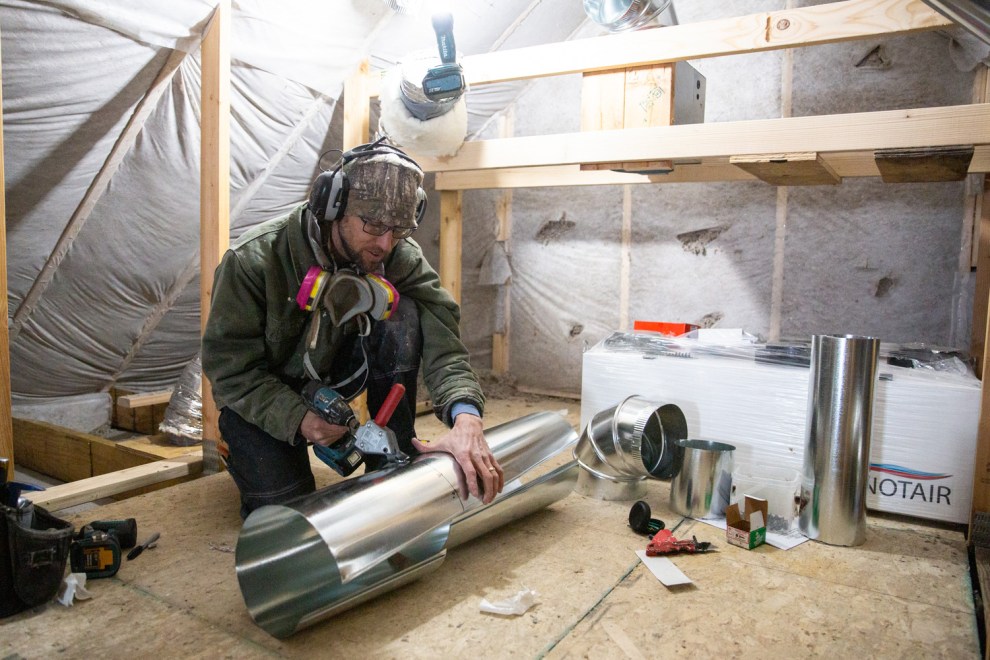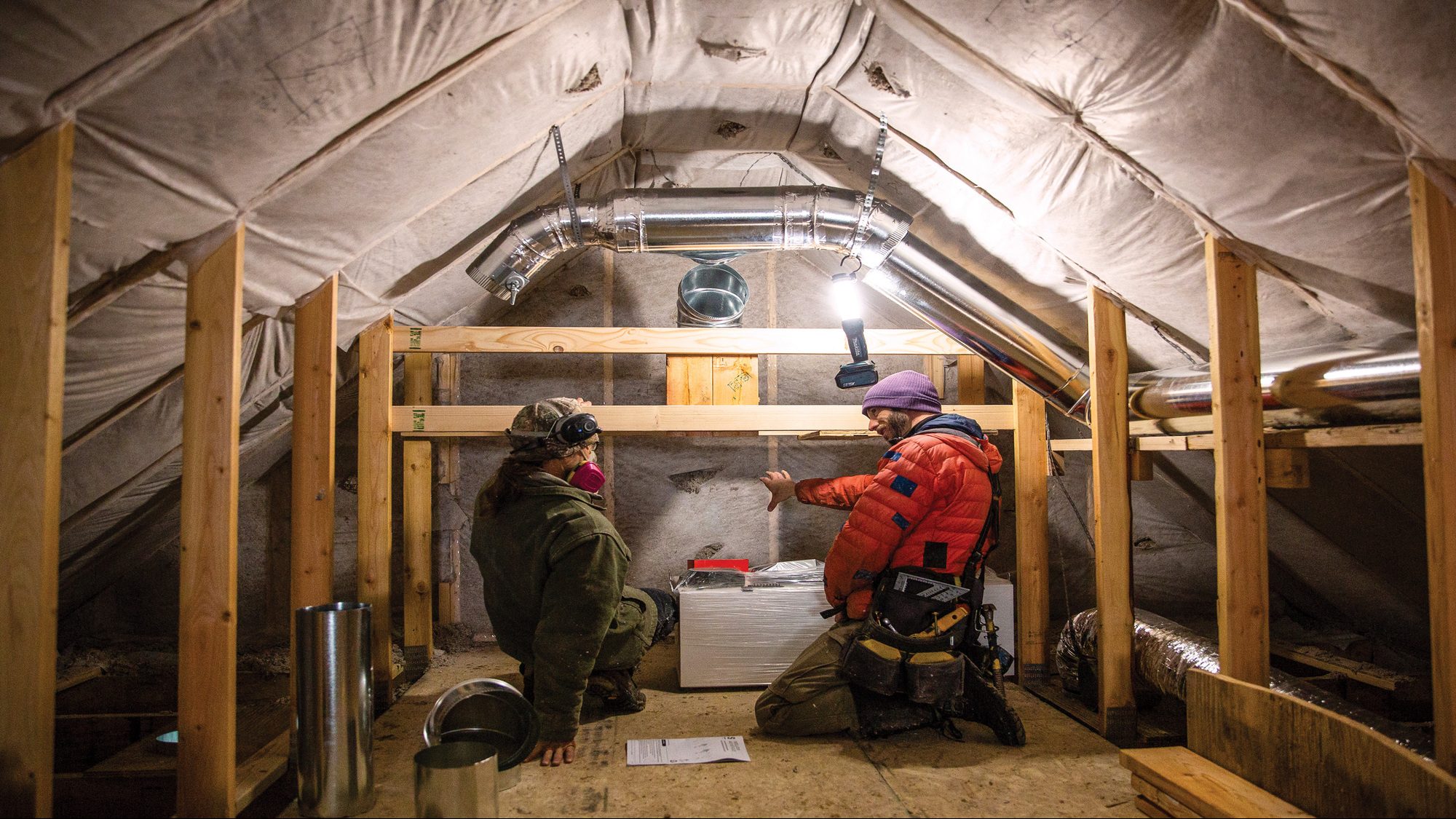The United States is on the brink of its most consequential transformation since the New Deal. Read more about it takes to decarbonize the economy, and what stands in the way, here. This story was originally published by High Country News and is reproduced here as part of the Climate Desk collaboration.
Gunnison, Colorado, at 7,700 feet above sea level, sees some of the coldest temperatures in the Lower 48. Its 6,000 or so inhabitants, especially low-income residents in older, poorly insulated housing, use more energy—often from natural gas—than their lowland counterparts.
Last year, Gunnison’s city government proposed cutting both greenhouse gas emissions and utility bills by making new homes more efficient and less reliant on fossil fuels. But Gunnison soon encountered the same obstacle that other communities do when they try to move toward electric heat pumps, stoves and water heaters: natural gas providers.
By vigorously campaigning against electrification policies in what are normally local battles, national natural gas utilities have opened a new front in the decarbonization struggle: building codes.
Building codes can either accelerate local carbon emission reductions or lock in fossil fuel infrastructure, according to David Konisky, a professor at Indiana University who studies environmental and energy politics and policy. When code changes nibble at utilities’ market share, however, the corporations bite back. “It’s not surprising that they will fight against these reforms,” Konisky said. “It’s cutting into their standard business model of people using natural gas for cooking or heating in their homes.”
In July 2021, Gunnison’s city council passed a robust climate plan aimed at cutting aggregate greenhouse gas emissions in half by 2030. The plan found that buildings produce 61 percent of county carbon emissions. The city’s 2022 proposal, building on the previous version, hoped to cut emissions by electrifying all new residential and commercial structures and half of remodels by 2030. This meant aligning Gunnison’s building code with current International Code Council standards.
Most American municipalities use some version of ICC policy. The most up-to-date policy requires new construction to be built “electric-ready,” so that switching from natural gas to electric appliances—and installing solar panels—is easier and cheaper. But Dallas-based Atmos Energy Corp., one of the nation’s largest natural gas utilities and a primary provider for Gunnison, elbowed its way into the process.

Cillian Liam Barrett in the utility closet of an electrified Habitat for Humanity home in Gunnison.
Luna Anna Archey/High Country News
On September 2, Atmos public affairs manager, Kurtis Paradisa, emailed the city government that his company would be “educating” its customers about its stance on electrification. In a mass email, Atmos warned Gunnison that the proposed changes “will have a big impact on housing affordability and restrict your choices for energy and innovative technologies.” (These emails were obtained in a record request by the Energy and Policy Institute, a utility watchdog group, and reviewed by High Country News.)
Gunnison Mayor Diego Plata called Atmos an important partner to the Gunnison community. But he acknowledged that the proposed code update would have “hit directly into their entire business strategy and plan.”
In a separate letter to Plata, Atmos Vice President of Marketing Ken Fogle argued that Coloradans overwhelmingly prefer natural gas, citing a study from the American Gas Association. This national trade group—Atmos is a member—spends millions of dollars annually on campaign donations and lobbying. Fogle also stated that the new policies would raise energy costs for Atmos’ Gunnison customers by more than $1,200 per year and that fueling appliances with natural gas results in lower carbon emissions than all-electric homes.
“We do believe that a balanced energy approach that includes natural gas and preserves energy choice, rather than supporting specific fuels or technologies, will achieve goals of reducing emissions while maintaining energy reliability,” Paradisa wrote in response to questions emailed by High Country News.
But Atmos’ claims appear based on questionable assumptions. Fogle’s energy-cost calculations rely on higher electricity costs than Gunnison’s standard rate and on Atmos’ natural gas costs from April 2022. Natural gas bills have shot up recently due to high demand here and overseas, as European countries scramble to find non-Russian energy sources. In September, the Colorado Public Utility Commission approved Atmos’ request to raise customers’ rates to account for higher gas costs.
As John Cattles, assistant county manager for operations and sustainability, noted in an email to Russ Forest, Gunnison’s then-city manager, Atmos was also comparing high-efficiency gas appliances to low-efficiency electrical appliances. Heat pumps can be several times more efficient than the most efficient gas furnaces even in cold climates, despite the industry’s frequent claim that they don’t work in extreme cold. And Fogle’s statement that natural gas has comparatively low carbon emissions appeared to omit the emissions from its extraction and transport.
Atmos found allies, however. In an email to Paradisa, city building official Eric Jansen said that he was “leaning toward recommending that the City just sticks with the currently adopted energy code,” or that it opt for “amending the heck out of” the proposed new code. This recommendation, he told Paradisa, would include “no mention of electrification” in the new building codes. Gunnison’s council members, he said, “have no inclination of going all electric any time soon.”
Gunnison’s debate echoed one that took place in Scottsdale, Arizona. Early last year, the city set out to update its building codes, despite a 2020 Arizona law that prohibits local governments from banning natural gas and blocks cities from implementing other energy-efficient building measures.
Scottsdale’s natural gas utility—Las Vegas-based Southwest Gas—fought back. In a letter to the city’s Building Advisory Board of Appeals dated March 2, Matthew Ligouri, senior public affairs manager for Southwest Gas, echoed many of the points Atmos made in Gunnison, even citing several American Gas Association studies. At a public meeting, Ligouri called the proposed building codes a “hard-left, ideological goal.” To date, the city has not attempted to adopt the electric-ready building codes.
In Gunnison, at a mid-October council meeting, Fogle testified and some residents spoke out against the policies. Ultimately, the city council voted to table discussion of electric-ready building codes. Jansen said Gunnison wasn’t ready for widespread electrification. (Jansen did not respond to a list of emailed questions.)

Edward Morrison installs a heat pump system in the attic of a new accessory dwelling unit in Crested Butte, Colorado.
Luna Anna Archey/High Country News
In the end, the city adopted policies that encourage solar-ready construction, while most of the energy-efficient building policies were set aside for three years. Mayor Plata agreed with the decision, saying that the city’s grid was not up to the task. But Atmos’ tactics concern him.“ Was it a little unsettling to see them reach out to all their clients and advocate that they come to council meetings and oppose this? Yes, I would say that was a little bit of pressure.”
Plata added that, given the urgency of the climate crisis, he hopes the city adopts energy-efficient building codes in three years.
At the national level, Republicans turned a federal agency’s plan to gather public comment on indoor air pollution from gas stoves into culture war fodder. But most fights over natural gas occur at the state and local level.
Democratic-led states are moving away from the fuel. California plans to ban all natural gas home and water heaters by 2030. Elected officials in Eugene, Oregon, banned natural gas hookups in new construction despite pushback from NW Natural, the state’s largest natural gas utility.
And though Gunnison failed to pass new building codes, nearby ski towns Aspen and Crested Butte recently succeeded, while Colorado’s Air Quality Control Commission is considering energy-efficient requirements for large buildings.
Meanwhile, a group called Coloradans for Energy Access emerged last year to fight what it calls “forced electrification” policies. Jennifer Altieri, Atmos’ then-vice president of public affairs for its Colorado-Kansas division, was listed as board chair in the group’s 2021 nonprofit tax documents.
In Ohio, Gov. Mike DeWine, R, signed a bill on January 6 that legally defines natural gas as a “green energy” source. A dark-money group backed by Ohio utilities—with ties to the American Gas Association—was instrumental in pushing it, according to the Washington Post. And Idaho lawmakers are looking to ban city-level natural gas restrictions, in a move that would mirror the Arizona law.
The utilities’ opposition to electrification is unsurprising, since a significant portion of their income comes from the use of natural gas for cooking and heating water and homes. But these fights are especially urgent now, Konisky noted, given that natural gas prices are high and President Joe Biden’s Inflation Reduction Act has begun taking effect. The law’s hundreds of billions of dollars for climate and energy policies include tax credits and rebates for building electrification, residential solar and energy-efficient appliances.
“My sense is that the utilities see the writing on the wall,” Konisky said. “The more utilities delay and keep the status quo,” he went on, “the better off they are financially in the short term.”













